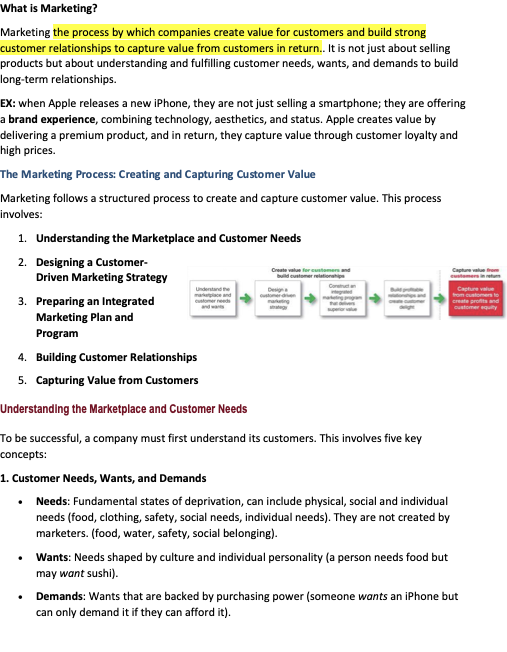Marketing chap 1
What is Marketing?
Marketing the process by which companies create value for customers and build strong customer relationships to capture value from customers in return.. It is not just about selling products but about understanding and fulfilling customer needs, wants, and demands to build long-term relationships.
EX: when Apple releases a new iPhone, they are not just selling a smartphone; they are offering a brand experience, combining technology, aesthetics, and status. Apple creates value by delivering a premium product, and in return, they capture value through customer loyalty and high prices.
The Marketing Process: Creating and Capturing Customer Value
Marketing follows a structured process to create and capture customer value. This process involves:
Understanding the Marketplace and Customer Needs
Designing a Customer-Driven Marketing Strategy
Preparing an Integrated Marketing Plan and Program
Building Customer Relationships
Capturing Value from Customers
Understanding the Marketplace and Customer Needs
To be successful, a company must first understand its customers. This involves five key concepts:
1. Customer Needs, Wants, and Demands
· Needs: Fundamental states of deprivation, can include physical, social and individual needs (food, clothing, safety, social needs, individual needs). They are not created by marketers. (food, water, safety, social belonging).
Wants: Needs shaped by culture and individual personality (a person needs food but may want sushi).
Demands: Wants that are backed by purchasing power (someone wants an iPhone but can only demand it if they can afford it).
2. Market Offerings
A market offering includes products, services, information, or experiences that satisfy customer needs. Companies must avoid marketing myopia, which is focusing too much on the product itself rather than the customer’s actual needs. (So paying more attention to specific products rather than benefits and experiences produced by said product)
Ex: Blockbuster focused on DVD rentals (product-focused), while Netflix focused on customer convenience (customer-focused), which led to Netflix’s success. & producer of a quarter-inch drills thinks that customers want the drill, in reality they need a quarter-inch hole.
3. Customer Value and Satisfaction
Customers form expectations about a product’s value before making a purchase. If expectations are met or exceeded, they are satisfied and will likely become repeat customers.
Ex: If a fast-food chain promises fresh ingredients and delivers stale food, customers will be dissatisfied and may never return.
4. Exchanges and Relationships
Marketing is about exchange—giving something (money, attention, loyalty) in return for something valuable (else) (a product or service). Companies aim to build strong relationships with customers by continuously delivering value.
Ex: Amazon offers fast shipping and personalized recommendations, ensuring customers keep returning.
5. Markets
A market consists of all actual and potential buyers of a product. It is a place where sellers and buyers exchange goods and services.
¨ Marketers must identify and target specific segments of customers who are most likely to buy their products.
EX: Tesla targets environmentally conscious consumers who are willing to pay a premium for electric cars.
Designing a Customer-Driven Marketing Strategy
Marketing management is choosing target markets and building profitable relationships with them. Aim is to engage, keep and grow the targeted customers by creating and delivering superior customer value.
A marketing strategy answers two key questions:
What customers will we serve? (Target Market)
How can we serve them best? (Value Proposition)
1. Selecting a Target Market
Companies do not sell to everyone; they divide the market into segments and choose a specific group of customers to serve (target marketing).
Ex: Nike segments its customers into different groups—runners, basketball players, and everyday fitness enthusiasts—and designs specific products for each.
2. Choosing a Value Proposition
A value proposition is the unique value a company promises to deliver to its customers.
Ex: Walmart’s value proposition is “Save Money. Live Better,” while Rolex’s is about exclusivity and prestige.
Marketing Strategies and Concepts
There are five main approaches companies use to develop their marketing strategies:
Production Concept – Customers favor affordable and available products. Companies focus on improving production efficiency.
Example: Henry Ford’s Model T was mass-produced to be affordable for everyone.
Product Concept – Customers prefer products that offer the best quality, performance and features. Companies focus on innovation and product improvements.
Example: Apple continuously improves its iPhone’s design and performance.
Selling Concept – Customers will not buy enough of a firms product unless the company undertakes aggressive selling and promotion.
Ex: Insurance companies rely on strong sales tactics to persuade customers to buy policies.
Marketing Concept – Companies should understand and satisfy customer needs better than competitors.
Ex: Amazon constantly innovates based on customer preferences, such as same-day delivery.
Societal Marketing Concept – Companies should balance customer needs, company profits, and society’s well-being. the idea that achieving organisational goals depends on knowing the needs and wants of target markets and delivering the desired satisfactions better than competitors do. It can be regarded as an “outside-in view”.
Example: Patagonia, an outdoor apparel company, promotes environmental sustainability.

 Knowt
Knowt